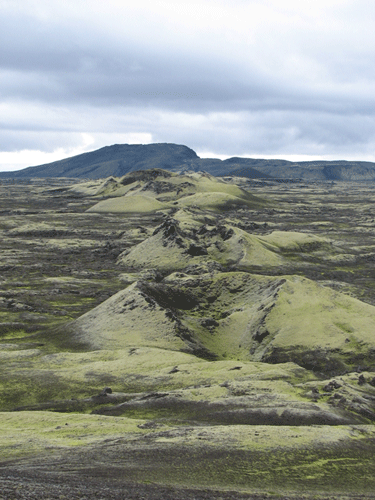
Before proceeding to the description of events at Lakagígar, please watch this video about Icelandic volcanism featuring the great David Attenborough. The footage will give you a sense of what a fire fountain emerging from a fissure looks like up close.
Video: David Attenborough on volcanoes, Filmed at Eldfell Heimaey (7:56)
[VOLCANO ERUPTING]
DAVID ATTENBOROUGH: I'm in Iceland. This fantastic funnel to the fire, rising 200 feet or so into the air behind me is Norter Rock. Fine ash is falling all around, there are gusts of choking poisonous gas, and it's so hot that this is just about as close as I could get.
The sheer weight of these molten [INAUDIBLE] of rock prevents them from being swept away by the gate of the veil. So there's little danger of them suddenly coming our way.
This is dramatic [INAUDIBLE], but perhaps most sinister is this tide of black slag that is slowly creeping over the surface of the land. In parts, it's red hot and molten and feels like [INAUDIBLE], but on the edges it's cold enough for me to be able to handle it. It's black, it's heavy and it's called basalt. And basalt like this has been welling up from deep in the Earth's crust ever since the beginning of the history of [INAUDIBLE].
A flow may travel for as much as 25 miles. Sometimes it moves no faster than a man can walk, but sometimes it races along at an extraordinary speed, 40 miles an hour, and nothing, nothing can stop it.
Sometimes so much lava is produced that it accumulates in flows 100 feet or so thick. Then the center layers of it cool exceptionally slowly and very evenly, and this is the result. Here at the John's Courseway in Ireland, the top of the lava flow has been eroded away for the eruptions took place 50 million years ago. The cooling contractions have produced the effect you can sometimes see in drying mud, though here the cracks extend to a much greater depth to produce six-sided columns about a foot and a half across.
Over the sea in the Hebrides, there's another lava flow that erupted at about the same time and formed the Fingal's Cave. The blanketing layer of lava that slowed down the cooling of the interior is still uneroded and beneath it the near perfect basalt columns rise almost 20 feet high.
Basalt that doesn't contain very much gas wells out from below almost quietly. But if the lava has been extruded under great pressure, it may be full of gas and then it behaves very different. Sometimes a flow sweeps down over a forest incinerating the trees in its path. Most dramatic of all, the lava sometimes wells up inside the deep crater and can't escape. Then it forms that most fieresome of nature's spectacles, a lava lake like this one in Outer Congo in Africa. This lava is at a temperature over 1000 degrees Centigrade, 2000 degrees Fahrenheit. The bubbles of gas that burst from its surface may be 50 feet across. Sometimes having got rid of much of its gas, like beer losing its fizz, it sinks back down the vast pipe from which it rose and returns to the lava chamber a mile or so below. But lava lakes fed by pipes are not common. Basalt will usually come to the surface of the Earth in a rather different way.
These Icelandic Volcanoes erupt from huge cracks or fissures which regularly open up in the line which runs right across the width of the island. When that line itself is only the Northern end of a huge line of weakness that runs for thousands of miles southwards from Iceland right around the side of the [INAUDIBLE].
Iceland lies between Norway and Greenland just South of the Artic Circle. The crack ridged over by lava, is for the most part under water which is why its existence wasn't known until the beginning of this century. From Iceland it runs midway between Europe and Africa to the East and the Americas to the West. In places it rises above the seas to form volcanic islands: the Azores, the Cape Verde, Ascension, Centilia, Tristan da Cunha. But below the surface the lava is continually erupting unseen by human eyes until only a few years ago.
The clouds of gas come from the lava itself, they're not steep. The pressure of the water of these depths prevents that from being produced. The heat is rapidly absorbed by the vastness of the ocean itself, so that the lava cools and congeals much more quickly than it would do in the air.